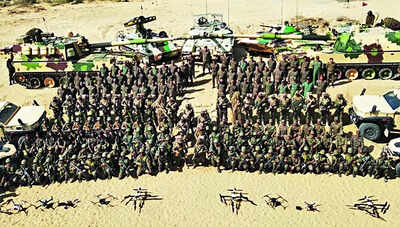NEW DELHI: With the successful testing of a newly-raised integrated ‘Rudra’ all-arms brigade in the major tri-Service Trishul exercise on the western front with Pakistan, the Army may now well upgrade its ‘Cold Start’ doctrine to ‘Cold Strike’ for swifter and greater offensive thrusts into enemy territory.This doctrinal evolution has gained ground after Southern Army Command chief Lt-General Dhiraj Seth said performance of the Rudra brigade under the 12 `Konark’ Corps, with integration of all fighting arms backed by combat support and logistics, was “fully validated operationally” during the `Akhand Prahar’ drills in the desert sector under the just-concluded Trishul exercise.“Now, with the Rudra brigade, the time has come to change the Cold Start doctrine into the Cold Strike one. I am fully satisfied that the Rudra brigades in the coming times will be successful in multi-domain operations and executing their task effectively against the enemy,” Lt-Gen Seth said.The Army had formulated its “pro-active conventional war strategy”, colloquially called the Cold Start doctrine, after its “strike formations” under Operation Parakram took almost a month to mobilise at the border launch pads against Pakistan in wake of the terror attack on Parliament in Dec 2001. By that time, Pakistan had shored up its defences, and the US also had jumped in to pressurize India against launching any cross-border attack. Having learnt a harsh operational lesson, the Army since then has been refining its strategy for faster mobilisation for multiple but limited offensives into enemy territory under the nuclear overhang.Pakistan, which does not have a “no first-use” nuclear policy like India, in turn, took to brandishing its short-range Nasr (Hatf-IX) and other nuclear-capable missiles as an effective counter to the Cold Start conventional military strategy.Now, the 11.5-lakh strong Army is converting a few of its over 250 single-arm brigades (each has over 3,000 troops) into Rudra all-arms brigades, with integration of infantry, mechanized infantry, armoured (tanks), artillery, air defence, engineers, signals and drone units, along with logistics and combat-support elements.In effect, a Rudra brigade brings together all fighting arms and support units into a self-contained group even during peacetime to ensure much better cohesion and faster mobilization for combined arms operations.Two Rudra brigades have already come up on the northern borders with China, one in eastern Ladakh and the other in Sikkim. “Each Rudra brigade will be tailor-made as per its earmarked area of operation, the type of terrain there and the operational task to be executed. The brigades will have units that can be attached or detached as per the requirements,” an officer said.As for the `Akhand Prahar’ drills, the “full-spectrum combat readiness” of the Konark Corps was validated through integrated employment of all arms and services from mechanised and infantry manoeuvres to the execution of land operations by the Rudra Brigade called ‘Black Mace’, special heliborne operations, and coordinated attack helicopter missions. “It also witnessed seamless synergy between the Army and IAF, with fighter ground attack missions in close support of the land forces,” another officer said.



